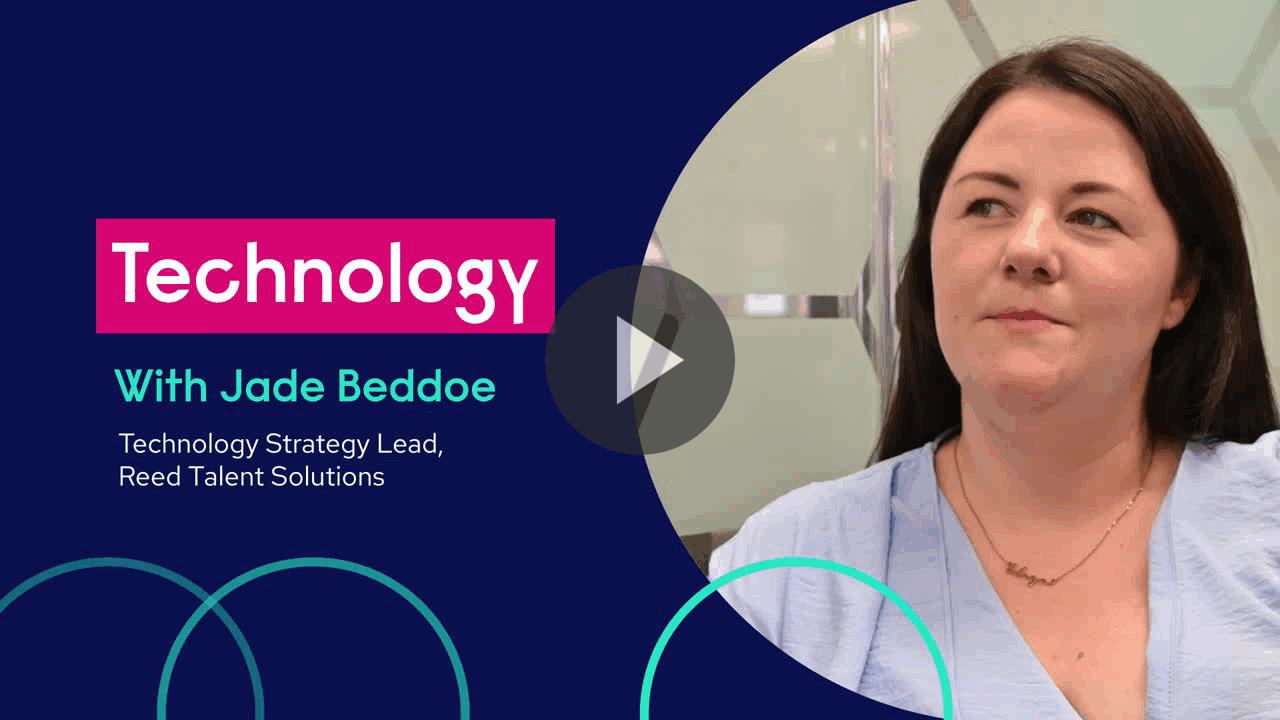Traditional recruitment methods have evolved drastically in recent years, notably with the rapid development of automation and artificial intelligence.
This powerful technology is capable of great efficiency and accuracy but can also bring its own challenges, such as a reduction in human interaction.
In this article, our Technology Strategy Lead, Jade Beddoe, reveals what role new technology has in the future of talent acquisition, as well as how it can support your equality, diversity, inclusion and belonging objectives.

Q: What role does technology play in being able to develop an organisation’s talent pipeline?
A: Technology plays a critical role in developing an organisation’s talent pipeline, particularly today in the talent landscape that we are in. We need to be able to unpick skills, cast our net as wide as we can, and look at those candidates and talent for today in our organisation, but also for the future.
Some technology, such as AI-driven matching technology help us to be able to look at a candidate’s skills and not necessarily just the experience within a CV. Then we also have things like jobs boards helping us reach candidates much more, social job advertising and LinkedIn.
I think additionally what we need to do now with technology is not just find them, but we need to be able to bring those candidates in and we need to be able to hold them in talent pools. We need to be able to engage them, we need to be able to nurture them, and then ultimately upskill them for when our needs change as an organisation.
Q: How can companies adopt AI in the process to make it more seamless for the candidate and efficient for the organisation?
A: There are so many ways that we can adopt AI to improve the efficiencies for candidates and employees, but I think that ultimately when organisations are doing that, they have to go about it with probably three key objectives in mind and they need to be able to be focused on experience, efficiency and fairness.
From a candidate’s perspective, we need to be able to pull out all of the laborious tasks and we need to be able to not ask them to duplicate their efforts when we are trying to bring them into an organisation. Anywhere that we can introduce generative AI, conversational AI, chatbots, or automation in the processing, I think is key for the candidate. And then, again, it is exactly the same for the organisation. What tasks are taking your employees away from speaking to candidates, speaking to talent, and try to generate technologies that are going to support that through AI.
Q: How can the effective use of technology support an organisation’s equality, diversity, inclusion, and belonging objectives?
A: I think this is twofold. Firstly, an organisation needs to really understand what their EDI&B objectives are and when they are looking for technology to bring into the recruitment process, they need to make sure that they are questioning their vendors on what their objectives are and how that technology is looking to solve some of those objectives for them. Specifically, I would want to cover things like accessibility and how the vendor is certified in that and what they are doing to progress and roadmap the technology to continue to do that for you.
And secondly is about the type of technology that’s brought in for certain stages of the process. If you were to take talent sourcing, you need to consider your jobs boards. Where are your jobs boards reaching, what demographics? And make sure that they are suitable for your objectives.
When you are looking at job advertising and you want to write your job adverts, how are you going to write those job adverts? If you are going to write them yourself, there is the chance that you will have unconscious bias. If you can bring in technology such as generative AI to be able to produce that content for you with unbiased language, you will be able to recruit better talent from a more diverse pool.
Q: What new technologies are likely to emerge or become more prevalent in the next two years that organisations may want to consider using?
A: I think what we will see become more prevalent is generative AI. I think we will see that bought into all of our technology applications that we are currently used to using for recruitment processes. In ATSs (applicant tracking systems) for example, where we are writing job applications, we will see AI integrated in, and we will be able to write job adverts really quickly. That’s already happening, and it is just going to develop all the way through that candidate journey.
Another place that we will see expansion is conversational AI and automation. I expect that recruitment will start to adopt virtual assistants, enhanced Chatbots for their service to candidates and to clients, it will mimic our recruiter’s tone of voice and we will be able to assist our talent and candidates 24/7
Another place I think we will see developments is in talent mapping, and AI helping us to map our talent better. Learning management systems are going to come to the forefront when we are seeing such a shift in the need to enhance and develop skills.
Another place, I think we will see some change is just in more robotic process automation. For the recruitment world it is going to be key. Anything that we can do to drive a quicker, less resource-heavy process - we will start to see technology advance in that field.
Q: What consequences and considerations will this technology bring for talent acquisition teams?
A: I think that AI, generally, is going to pose a number of potential consequences. We’re going to need to make sure that where we are interacting with candidates using AI that we are being transparent. We are going to have to make sure that the vendors that we are using to help us assist in these processes with AI are working ethically. I think we need to be aware of the possibility of bias in AI where it is not being used correctly.
We need to make sure that we are utilising AI and technology in places where it will only enhance the candidate experience. Again, to take it back, it’s about looking at efficiencies, looking at experience, and looking at fairness.
From a talent mapping perspective, I think it is going to really turn the tide. It’s going to be, right, what do we need, where is our organisation going in the next two, five, ten years, and what talent do we have here – how do we keep them engaged, how do we keep them in our organisation developing their skills so they are still the employees of our future rather than having to go back out to market and look for skills that are going to be really difficult to source.
Q: While technology is clearly important, to what extent will the human touch still be needed?
A: I think this is the question that everyone likes to ask. We know that as humans, we enjoy human interaction, but we also do not want to be inconvenienced.
The perfect blend of automation and AI has to be really considered. Where do you add most value to your candidates, to the talent in the marketplace when you are speaking to them directly, when you are giving them their time? What do they want from you? And I think in many cases they want to be able to self-serve, to go on to an application at any time in the day and complete that application. What they also want to be able to do while they complete that application is answer the questions they may have. If we can do that through virtual assistance, if we can do that through chatbots, I think that is going to create a great advantage for everybody.
I also think that candidates want to be able to choose when they speak to us. If we can offer candidates the opportunity to see our diaries, schedule in a chat with us, then we are much more likely to be able to interact with them in a meaningful way.
We live in a very busy world now and people just do not have the time to schedule a 45-minute conversation at three o’clock on a Tuesday every week, so we have to be able to give the candidates the ability to see and book themselves in.
I think that would lend us to be able to have those conversations with the candidate when they want to, which is going to make them so much more meaningful. It’s going to give them a better experience. We’re going to get out of them what we need from them at the right time, which is going to improve the pace of the process and get them into their role quicker.
To find out more about getting the perfect balance between an efficiently automated and a humanly personalised recruitment process, download our eBook ‘Blending automation and human interaction to enhance the candidate experience’





